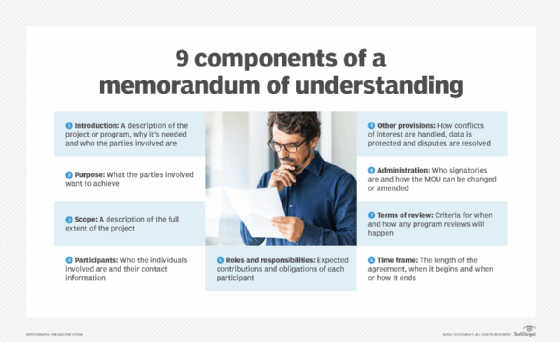memorandum of understanding (MOU)
What is a memorandum of understanding (MOU)?
A memorandum of understanding (MOU) is a formal agreement that outlines plans for a common line of action between two or more parties. An MOU is used when companies plan to work together or partner on a project or similar venture. In government, these agreements are used to coordinate interagency work.
MOUs are usually not legally binding and are less formal documents than a more-binding contract. However, they are taken seriously in business transactions. MOUs are stronger than a gentlemen's agreement or a handshake. They are often the first steps companies take toward a legal contract.
How does an MOU work?
MOUs provide a roadmap of each party's duties and requirements. These documents are usually created at the early stage of a relationship or initiative and do not involve an exchange of money. Participants working on an MOU get to state their expectations and resolve potential conflicts before moving on to the contract negotiation stage.
An MOU should include the following:
- names and contact information of the parties involved;
- context and purpose or goals of the agreement;
- approximate date when the agreement will become effective; and
- signatures of all parties involved.
In U.S. law, a memorandum of understanding is synonymous with a letter of intent, such as those used by managed service providers. Both are nonbinding, written agreements that imply a binding contract is to follow.
In international law, an MOU is a political mutual agreement between two or more parties. It is less formal than a treaty and not legally binding. They are popular in international relations because, unlike treaties and treaty negotiations, they take a short time to ratify and can be kept confidential. MOUs may also be used to modify existing legal treaties.

An MOU vs. a memorandum of agreement
A memorandum of agreement, or MOA, is an alternate term for memorandum of understanding. They are essentially the same kind of document that expresses a mutual understanding between two or more companies, government agencies or other parties. Both MOAs and MOUs often precede a more formal, detailed legal document or agreement.
One important difference: A MOA is an enforceable document and can be enforced in a court of law. An MOU is generally a nonbinding agreement unless all parties sign it and some sort of consideration -- such as a fee -- is exchanged.
Legal foundation for MOUs
The legal support for MOUs dates back to 1872 with the Indian Contract Act. This document spells out circumstances under which a formal contract may be initiated, changed and canceled. It provides considerable detail on many types of agreements.
Section 10 of the act – "What agreements are contracts" -- describes what kinds of agreements are contracts. It states: "All agreements are contracts if they are made by the free consent of parties competent to contract, for a lawful consideration and with a lawful object, and are not hereby expressly declared to be void."
Other laws and precedents have been developed over the years, but the Indian Contract Act provides the most relevant and understandable explanations of an MOU.
Partnering in the IT industry can be tricky. Learn about new approaches, such as co-innovation and generative partnering.
